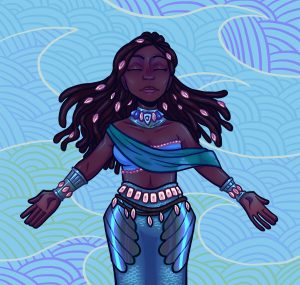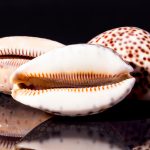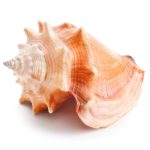

Science shows that all human life began in Africa. So it’s no surprise that on the west coast of Nigeria we find the orisha Yemaya, Goddess of the Seven Seas, known as the “Mother of All.”
Yemaya is often shown with conch shells. She fills them with her comforting voice. She is also shown with cowrie shells. She fills them with the gift of fertility. As a nurturing mother, Yemaya wants her children to be their authentic selves. That’s the message in the Venus Comb Murex shell. Later in this article, you’ll find:
- A simple ritual using cowrie shells
- A ceremonial ritual using the Venus Comb Murex shell
- A ritual to honor Yemaya and the victims of the Middle Passage
My own Celtic ancestry and life experiences never connected me with Yemaya and other orishas. I learned about them through traditional research and through conversations with several friends. When they told me about their deities, the orishas, I likened the concept to the Catholic saints I’d grown up with, except the orishas seemed more powerful and definitely more personal.
In any culture where the majority of people don’t use a written form of language, mythology, like that of Yemaya, and symbols, like seashells, feed our hunger for the mystic, and contain valuable information about how to live a good life. That’s why including items like shells, or beads, or flowers helps us connect to the deeper meaning in rituals.

Yemaya and Cowries
Yemaya is often shown wearing cowrie shells. Cowries can be found all over the world, and all over the world, the shells were used as currency. They were worn as jewelry, traded for silk and spices, sewn on clothing, made into rattles, and more.
There are many varieties of cowrie. All have a round or elliptical feel. They range in size from a fraction of an inch to two inches, sometimes longer. While the look of the shells can vary in color and pattern, cowries are always smooth. That’s because the mollusk that secretes the “glaze” that gives the shell that smooth surface lives on the outside of the shell, not the inside as with other mollusks.
In ancient Rome, cowries were considered symbols of Venus, goddess of love. One side of the cowrie has a narrow slit with a puckered opening and the other side looks like a pregnant belly. Viewed as symbols of fertility, cowries were often given to brides on their wedding day. In other parts of the world, women in labor would clutch cowries in the hope of a safe and pain free delivery.
Today, some women wear a cowrie necklace and intentionally place the shell with the opening visible to signal their desire for a relationship.
The opening also symbolizes a mouth, and the idea that a woman wearing a cowrie has a voice and something to say. Listen up!
In ancient Egypt, small cowries were placed into the eye sockets of mummies in the belief that the shell would provide vision in the Afterlife. Maybe that was because they used the kind of cowrie that resembles an eye. Or maybe the Egyptians believed, as did the Yoruba, that shells come from the gods. The cowrie in particular was thought to be the mouthpiece of the gods.
Tiger Cowrie Ritual: Pregnant with Creativity
In my seventies now, I’m long past the stages of childbirth and menopause. That doesn’t mean my days of creativity are over. Just the opposite. I’m immersed in multiple writing projects, a podcast, and my work as a wedding officiant and a Life-Cycle Celebrant.

On my altar I have a large, tiger cowrie, a gift from my daughter. Along the shell’s portal is a thin strip of leather. When I’m ready to plant the seed of a new project, I remove the leather and insert something into the belly of the shell. That something might be a small, tightly folded piece of paper on which I’ve written my goal for the project. It might be a crystal chip — such as iolate to give me a new perspective on the project, rose quartz to imbue the project with love, citrine to transform any doubts I have about my abilities.
I rub frankincense oil on the portal to protect the energy I’ve put into the cowrie. On nights when the moon is new, I place the shell on the windowsill. When the moon is new, it can’t be seen at all. The energetic message is to pay attention to what our instinct tells us. It’s the ideal time to plant the seed for what we want to grow.
Small Cowrie Ritual: Speak Up
You can purchase small cowries in bulk. Use them in a simple ritual to help you find your voice and use it. Use two containers the same size. Fill one of them with cowrie shells. Every morning, remove one of the cowries. Hold it with the mouth facing you. Think of the cowrie as the mouthpiece of the Divine, however you define the Divine. Speak out loud and directly to the portal of the shell.
Make one, clear statement. What you say is up to you. It might be a statement of confidence, or of your value, or your dreams, or your boundaries. What’s important is that you articulate your thoughts. Once you’ve filled the cowrie with your voice, place it in the other container. Repeat this little ritual every day until the first container is empty.
Then, in the same way you would flip an hourglass, start all over again. This ritual is best done in the early morning when the Sun is newly born and growing in power. Face the east, call upon the spirits of air, the realm of clear thinking and fresh ideas.
Don’t worry if you don’t achieve immediate results. Your voice wasn’t silenced all at once. Give it time.
Yemaya and Conch Shells

In addition to cowries, Yemaya is also associated with conch shells. In episode 49, I talk about why knowing the language of shells is important, especially if you’re having a beach wedding. In that episode, I talk about the shell known as the Pink Conch, or the Queen Conch. It’s one of the shells you can hold to your ear and hear the ocean. More specifically, you can hear the rhythmic, soothing voice of the Ocean Goddess of the Seven Seas.
Ritual with Venus Comb Murex: Your Authentic Self
Yemaya is the nurturing mother. When her children are suffering, she bathes them with water. She soothes their pain. She washes away their sorrows. As her children grow and become teens and young adults, Yemaya wants them to develop self-esteem, to understand that their needs are as important as those of others.
It’s that aspect of the goddess that inspired the ritual I call “Your Authentic Self.” It’s based on the meaning of a shell called the Venus Comb Murex.
There are hundreds of thousands of species of shells. Of those, there are an estimated 1,200 species of murex shells. One of them is the Venus Comb Murex. The shell gets its name from the long spines that resemble the teeth of a comb.
While some people associate combs with vanity, when we care about our grooming we’re making a statement that we care about ourselves. Throughout history, women have received the message that we are NOT valued when we take care of ourselves first. We’re valued when we take care of others first. And yet when we’re on an airplane and the flight attendant is pointing out the overhead location of the masks “should oxygen be required,” we understand the wisdom in putting your own mask on first before you try to help someone else.
In her book Ocean Oracle: What Seashells Reveal about Our True Nature, Michelle Hanson shares her thoughts on the Venus Comb Murex. She writes how, all too often, women think their value comes only from giving and doing for others. She concludes that such a one-way path leaves the woman depleted, never knowing if she is appreciated — loved — for being her authentic self.
To me, that truth makes the Venus Comb Murex an ideal shell for those on a journey to learn self-love — the truth Yemaya wants all women to find.
What follows is a longer and more complex ritual than what I created for the cowrie shells. The nature of this ritual is ceremonial, making it ideal for a group, or for you to do on your own. When you’re ready to do this ritual, gather these items:
- A shell, any kind. This shell will represent Yemaya.
- A Venus Comb Murex shell. You don’t need the actual shell. An online photo will work just fine. Print it and place it on your altar.
- A container of water. You can use a pretty pitcher or a simple bottle.
- A bowl. Find a blue bowl, or a white bowl to which you add a drop of blue food coloring, or set a white bowl on a blue hand towel.
- A small container of salt. You only need a pinch of salt. Still, as with the bowl, give thought to the container you choose. You’re creating a symbolic womb.
- An assortment of blue and white beads. Gather at least 7. You can certainly purchase beads, or make your own with clay, or get wooden beads and paint them. Or, take beads from jewelry that no longer serves its original purpose.
If you do this ritual in a group, decide before you begin if all the beads will be placed in one container, or if each person will have her own bowl and her own beads. If this is a group ritual, you can meet prior to the ritual to create the beads you’ll all use. I can imagine a circle of women painting wooden beads blue then adding simple white flowers.
- Elasticized string to make a simple bracelet. Twelve inches is normally enough to let you string your beads and easily tie a knot.
- A dot of clear glue to reinforce the knot
- A hair comb
- 2 glasses of drinking water
- A small container of goldfish crackers
Clothing: Wear blue and white. Or simply clip white and blue ribbons in your hair. Or tie them around your wrist.
Music: As you prepare your space, play ocean sounds. A simple search on YouTube will give you plenty of options. During the ritual you’ll create a bracelet. When you place it on your wrist, play the song “Yemaya” from the CD Ancient Mother by Robert Gass and On Wings of Song. You can hear that on YouTube, as well. Be sure you have room to dance. You’ll want to.
The Working:
- Set the shell that represents Yemaya in front of the bowl and make yourself comfortable.
- Take 3 deep, cleansing breaths. Science shows that deep, diaphragmatic breathing supports the lymphatic system. That’s the body’s garbage removal system. The deep breath puts just enough pressure on the lymph nodes to eliminate toxins, making the breath literally cleansing.
- Mindful that you are doing a ritual, pour the water into the bowl.
- Pinch by pinch, add the salt to the water.
- One at a time, pick up your seven beads. As you hold each one, imbue it with the energy of some aspect of yourself — some aspect that you feel isn’t always recognized or appreciated by others. Make your statements out loud. That’s important! For example, you might say:
“I’m good at getting people to work together.”
“Family and friends rely on me.”
“People can trust me.”
“I keep my promises.”
“My opinions matter.”
“I go out of my way to help others.”
“My art is worthy of the time it takes to create.”
- As you put your thoughts into each bead, put the bead into the water.
- Once all seven beads are in the water, swirl the water with your fingers (or your hand if the bowl is big enough). Swirl clockwise , the movement that builds energy because it follows the daily movement of the Sun. Take your time on this step. As you listen to the sounds of the ocean, imagine Yemaya hearing your words, affirming their value, anointing your beads.
- One at a time, pull your beads from the water and string them on the elasticized thread. Tie a knot. You’ll need to wait until your beads and the thread are good and dry before you add the drop of glue. While you wait …
- Look at your picture of the Venus Comb Murex and comb your hair. Imagine Yemaya assisting you. This step is symbolic. If you don’t have a comb, use your fingers. Think about what you’re doing. Know that caring for yourself is an act of self-esteem.
- Slip on your bracelet. Know that you cannot control how someone else thinks. You can control how you present yourself, how you think about yourself. Ask Yemaya to reveal your inner beauty.
- Play the song Yemaya. Play it loud. Dance!
- Ground your energy by eating your goldfish crackers.
- Bless your experience by toasting Yemaya and drinking your glass of water.
- Finally, make a libation to Yemaya by pouring the water from the other glass onto the earth. Adding it to a potted plant will work just fine. If you can’t get outside and you don’t have a potted plant, stand in the shower and pour the libation over your body. If you’re doing this ritual in a group, pour the water over each other.
The Middle Passage
This is the second of a two-part series on seashells and ocean goddesses. In the previous article, I dove into the myth and magic of Sedna, the Inuit Goddess of the Arctic Ocean. She is mother to the seal, walrus, and whale. Her people come from the Arctic regions of Canada, Alaska, Russia, and Greenland.
Yemaya’s people, the Yoruba, originally came from the west coast of Africa in the areas of Nigeria, Benin and Togo. During the scourge of the Middle Passage, Yemaya’s people were kidnapped and brought to the Americas. With them, came Yemaya.
Artists often show Yemaya wearing full skirts with seven layers of blue and white — blue for the ocean’s water, white for the lacy foam on the waves. That’s not mere artistic license. Yemaya’s realm is the upper layer of the ocean. While that has always been important to the Yoruba, it had to have given immeasurable comfort to them and to other Africans who died crossing the Atlantic on The Middle Passage.
The name refers to the second part of a three-part journey made by cargo ships sailing from and to Europe. These voyages lasted for hundreds of years and are said to have begun on August 18, 1518. That’s when Charles 1, King of Spain, issued a charter authorizing the transportation of slaves directly from Africa to the Americas. The slave trade lasted into the mid-1800s.
The first passage was from Europe to the West Coast of Africa. The cargo hold was full of iron, firearms, gunpowder and brandy.
When the ships reached Africa, the cargo was exchanged for human beings. Many of these men, women, and children had been kidnapped from the interior of Africa and kept in dungeons for a year or more, waiting for the ships to arrive.
Filled now with human cargo, the ships made the second leg of the journey, the “middle passage,” landing first in the West Indies, then in other parts of Latin America, and eventually into English colonies in North America. Each crossing took between 21 and 90 days.
In the Americas, the African slaves — the human beings — were sold or exchanged for new cargo. Loaded now with tobacco and sugar, long timber, coffee and other items, the ships made the third leg of the journey and returned to Europe.
Millions of Africans were forced into the Middle Passage. It’s estimated that between ten and twenty percent of them died during the voyage, some to violence, some to injury, and some to disease. It was not uncommon for the captain to have those slaves — human beings — thrown overboard, often chained together. So prevalent was the custom that sharks quickly learned to follow the slave ships.
Whatever horror you just imagined was, no doubt, eclipsed by reality.
If you can, imagine what went through the minds of the Africans still on board. Whether or not they saw other captives murdered, they had to have heard the screams.
Now, what if you believed with your whole heart and soul that the moment your loved ones fell into the blue water surrounded by white-laced waves…that they were instantly, safely, embraced in the strong and comforting arms of Yemaya, the Mother of All?
The Ocean Remembers
I tell you about this criminal, shameful time in history for a reason. Just as I think the land remembers what happened on it, I think the ocean remembers, too. As the world’s climate changes, as glacier ice melts and all the oceans rise, the stories of those sacrificed to the watery depths are rising, too.

The story of the Africans who died during the Middle Passage — that story lives in the Atlantic Ocean. Of course, there are no concrete borders to oceans. And we’re all familiar with the miniature ocean created in the womb as part of being pregnant. So I wonder … before being born, do we swim in an ocean containing a micro chapter of a larger story?
On a historical and cosmic level, how do the stories of Yemaya and the Middle Passage illuminate our understanding of the words “Black Lives Matter”?
Did our personal ocean carry the memory of Sedna, the Inuit girl who was betrayed, whose murder gave life to all the warm-blooded creatures of the Arctic Ocean?
On a geographic and cosmic level, how does Sedna’s story awaken us to the dangers of climate change and fuel our commitment to save the planet?
Ritual: The Day of Healing
As mentioned above, the slave trade known as The Middle Passage is said to have begun on August 18, 1518. A hundred years later, on August 25, 1619, The White Lion landed in Jamestown, Virginia. It was the first slave ship to come to English colonies in America. August 25 has since been declared the “Day of Healing.”
If you plan to be on the water this August 18 to 25 — whether on a cruise ship with hundreds or in a kayak by yourself, or standing in the surf with friends, drop a white flower in the water. As you do:
- Acknowledge the pain and inhumanity of the slave trade.
- Thank Yemaya for the comfort she provided to the millions whose lives and legacies were lost or forever changed because of the Middle Passage.
- Vow to lend your voice to the truth that Black Lives Matter.
- Visualize a more just and compassionate world.
That last suggestion isn’t fluff. Thoughts precede decisions and actions. If we want a more just and compassionate world, we have to visualize it first. We have to imagine it, and imagine our role in making it happen.
As my dear friend Victoria Burdick said to me, “Between now and dead, you’ve got a purpose. Don’t be timid.”


2 Responses to Episode 51- Yemaya, the Yoruba Orisha “Mother of All” – Part 2 of Seashells and Ocean Goddesses